#the canon of Notre Dame Cathedral
Photo

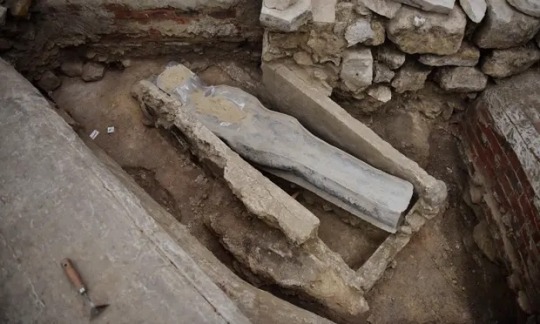
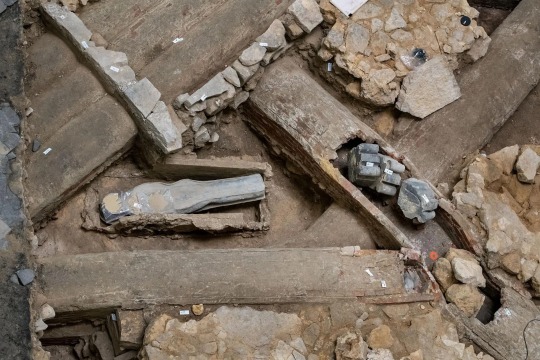


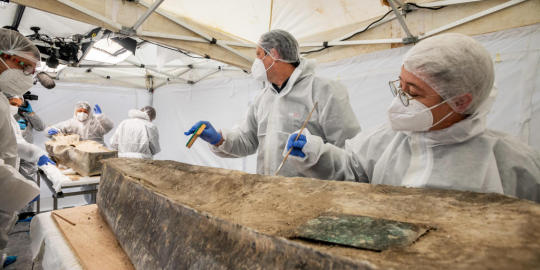



Notre Dame’s Uncovered Tombs Start to Reveal Their Secrets
Two sarcophaguses unearthed in reconstruction work after 2019 fire identified as elite canon of cathedral and young cavalier
Two lead sarcophaguses discovered buried under the nave at Notre Dame Cathedral in what was described as an “extraordinary and emotional” find have begun giving up their secrets, French scientists announced on Friday.
The first contains the remains of a high priest who died in 1710 after what experts say appeared to be a sedentary life. The occupant of the second has not yet been identified – and may never be – but is believed to be a young, wealthy and privileged noble who could have lived as far back as the 14th century.
The tombs were uncovered as part of a cache of statues, sculptures and fragments of the cathedral’s original 13th-century rood screen buried under the floor of the transept crossing at the heart of the cathedral that was ravaged by fire in April 2019.
The burial sites were described as of “remarkable scientific quality” and were found after a preventive dig under the floor where heavy scaffolding is to be erected to install the cathedral’s new spire.
While most of the treasures were discovered barely 20cm (8in) under the cathedral floor, a body-shaped lead sarcophagus was buried one metre deep.
Once opened by specialists in Toulouse, it was found to contain what was left of a man, probably in his 30s, who researchers have named “Le Cavalier”, as his pelvic bones suggest he was an experienced horseman.
There was no name plaque on the coffin, which was moulded around the shape of the body, and holes in the lead around the head meant the remains had been exposed to the air and severe deterioration.
Scientists are continuing to examine fragments of cloth and plant material found inside the coffin and say he was embalmed – a rare practice in the middle ages – and appears to have been buried with a crown of flowers.
A brass plaque on the second lead sarcophagus, also exposed to the air and water infiltration from the historic flooding of the Seine in 1910, confirmed that it contained the remains of Antoine de la Porte, the canon of Notre Dame Cathedral who died on Christmas Eve 1710 aged 83.
Eric Crubézy, professor of biological anthropology at the University of Toulouse III, who oversaw the cutting open of the coffins, said the two men were clearly important in their respective eras to have been buried in such prestigious tombs at the heart of the cathedral.
The unknown cavalier would have been a member of “the elite” at the time of his death to have been interred at the foot of the large cross on the since-destroyed rood screen, an ornate partition between the chancel and the nave that separated the clergy and choir from the congregation. Most rood screens were removed from France’s Catholic churches during the Counter-Reformation in the 16th and 17th centuries.
The young man had suffered a “chronic disease” that had destroyed most of his teeth by the time he died, Crubézy told journalists. “He would have had a difficult end of life.” The dead aristocrat also had a deformation of the skull caused by wearing a headdress or headband as a baby.
Christophe Besnier, who headed the scientific team for the dig carried out by France’s national archaeological institute, Inrap, told a press conference: “If the date of his death was around the second half of the 16th century or early 17th century, we may be able to identify him in the death register that we have. If it’s earlier than that, we probably won’t ever know who he was.”
Unlike the cavalier, de la Porte had “extraordinarily good teeth”, Crubézy said. “They were remarkable for his age. We see this very rarely, but he clearly cleaned his teeth and took care of them.”
De la Porte was rich, influential and not only commissioned several works of art that are now in the Louvre, including a painting by Jean Jouvenet entitled The Mass of Canon Antoine de la Porte, but paid 10,000 livres – a small fortune at the time – for the renovation of the choir of Notre Dame Cathedral. Part of the destroyed rood screen was used in constructing his tomb.
After fire swept through the 850-year-old cathedral, one of Paris’s most symbolic and visited monuments, in April 2019, almost destroying the entire edifice, President Emmanuel Macron pledged to have it rebuilt and open for mass in five years.
The Inrap team was called in to carry out a “preventive dig” under a section of the cathedral floor between February and April before a 30 metre-high, 600-tonne scaffold was built to reconstruct the monument’s spire. The archaeologists were given a strict timeframe and only a specific area in which to carry out the excavation.
Dominique Garcia, president of Inrap, reiterated that the human remains were not “archaeological objects” and would be treated “with respect from beginning to end” of the research before being returned to Paris for the culture ministry to decide what would happen to them.
By Kim Willsher.
#Notre Dame’s Uncovered Tombs Start to Reveal Their Secrets#sarcophaguses#grave#tomb#Antoine de la Port#the canon of Notre Dame Cathedral#archeology#archeolgst#ancient artifacts#history#history news#ancient history#notre dame cathedral#long reads
15 notes
·
View notes
Text
Notre Dame’s uncovered tombs start to reveal their secrets
9th December 2022.
#notre dame cathedral#paris france#paris#uncovered tombs#archaeological site#france#the guardian#archaeology#religion#sarcophaguses#elite canon#young cavalier#Antoine de la Porte
43 notes
·
View notes
Text

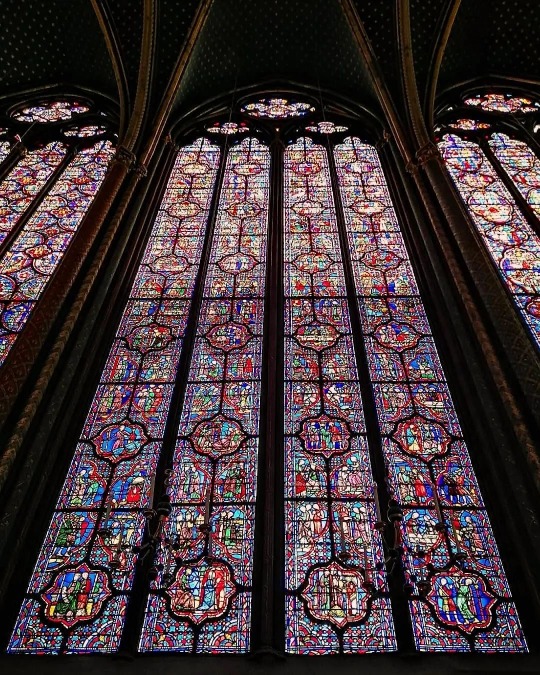
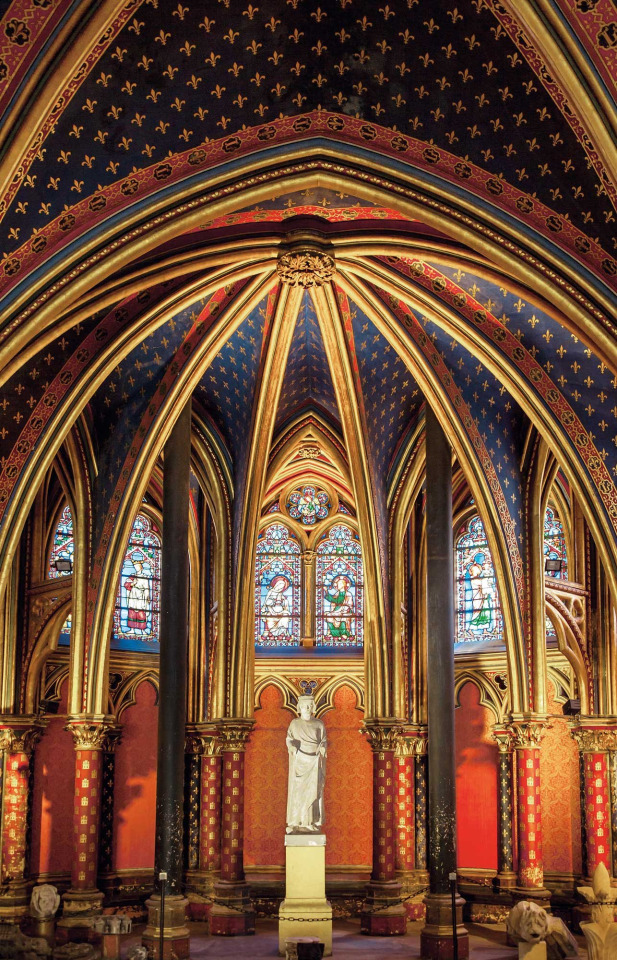
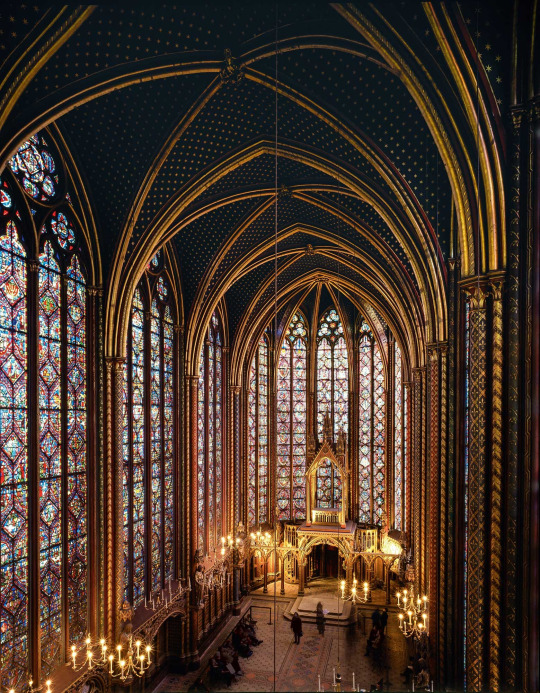

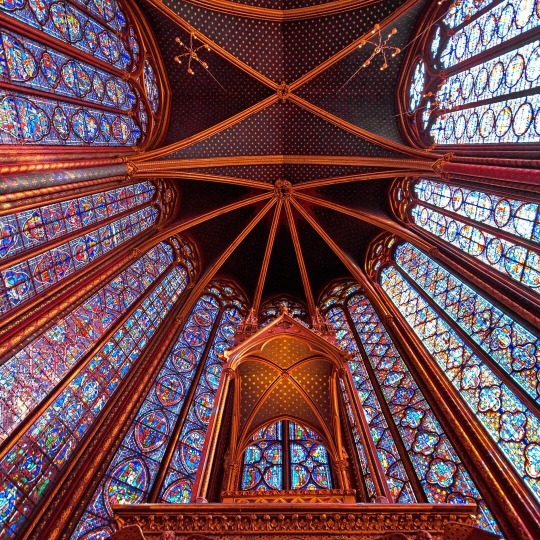
Sainte-Chapelle, the jewel of the Gothic.
Louis IX of France nicknamed the Saint, son of Blanca de Castilla (in turn daughter of Alfonso VIII and Eleanor de Plantagenet) and Louis VIII, has been considered the ideal of the medieval Christian monarch, a very devout king who dedicated his life to prayer, charity and asceticism... in addition to being the last European king to participate in the last two crusades: the Seventh between 1248 and 1254 and the Eighth in 1270, he took Saint Louis to Tunis and there he would die of the plague at the age of 56 and 40 of reign. In 1297 he will be canonized by Pope Boniface VIII.
His devotion and religiosity led him to acquire numerous relics and among them the coveted crown of thorns of Christ. Brought to France from Constantinople, Louis IX decided to organize a sacred place to keep and protect the holy collection. Thus in 1242 the construction of the Sainte-Chapelle would begin, which was consecrated in 1248. Little is known about the authorship of the chapel, it has been attributed to Pierre de Montreuil, master of the radiant Gothic and main architect of the reign of Saint Louis.
The enclosure was conceived as a reliquary or jewelry box where to deposit the precious and holy relics of the Passion of Christ. The chapel is 36 m long, 17 m wide and over 42 m high.
Its walls covered with precious stained glass windows, 15 in total, have representations, among other themes, of the Old Testament as well as the transfer of the crown of thorns to Paris.
These large openings filter the light, causing it to break down into different colors, symbolizing divine power and turning the place into a sacred and spiritual space. It is a large glass urn whose slender ribbed vaults, 20 m high, rise as if bringing us closer to God. In 1630 it went up in flames, a great fire destroyed it to a large extent and during the French Revolution its relics were stolen and many destroyed by the revolutionaries. Some were saved and are now kept in the treasury of Notre Dame Cathedral. In the S. XIX was the object of an extraordinary restoration, but preserving the spirit, fidelity and medieval beauty that it had in its origin.
172 notes
·
View notes
Text

papa emeritus III moodboard
ah, here comes the one y'all have been waiting for, the one who serves the most cunt and then some more. the shortest but the loudest, our grammy winning papa!
1st photo: tarot cards -> he's the one who has a knack for divination, he also does tea leaf readings
2nd photo: outfit -> he does not leave his room without his jewellery, he doesn't even care if he has to wear gloves over his rings
3rd photo: broken wine bottle -> he is a dramatic ass bitch, he has thrown bottles and glass full of wine at people
4th photo: purple velvet -> you know the gist by know, don't make me repeat myself
5th photo: terzo, darling, you really need to change your shoes. and we need to get you a new kazoo, stat.
6th photo: occult books -> goes with the first photo, he has the most affinity for the occult
7th photo: a gothic cathedral -> he'd live here like quasimodo from hunchback of notre dame and ring those bells
8th photo: insert a "he is canonically dead meaning he's reached his dead end" joke here, pt. 3
9th photo: meliora -> do you think he made his papa proud with winning a grammy for cirice?
papa moodboards: 3/4
all photos were found on pinterest
full list of moodboards
23 notes
·
View notes
Text
Btw they opened the lead coffins excavated at Notre Dame, so be on the lookout for fun new curses!
One coffin belonged to Antoine de la Porte, canon of Notre Dame in the late 17th century; the other belonged to a young aristocrat, they think, era uncertain, who they've dubbed Le Cavalier because he likely spent a lot of time on horseback.
(together, they fight crime!)
173 notes
·
View notes
Text
Overview and Criteria for Gothic Fiction
Gothic as a genre of fiction novel emerged in the late 18th century and early 19th century. Modern scholars frame these works as part of a Romanticist pushback against the Enlightenment era of calculated, scientific rationalism. In English literature, these may also have been artistic expressions of the collective anxieties of British people regarding the French Revolution. The term hearkens back to the destruction of the Roman Empire in the 5th century CE at the effect of Gothic peoples, an event that marks the beginning of the medieval era. As early as the year 1530 CE, Giorgio Vasari criticized medieval architecture as gothic, that is "monstrous", "barbarous", and "disordered" contrasted against the elegant and progressive neoclassical architecture reconstructions. In the late 20th century, a subculture of post-punk horror rockers began to be described as Gothic as well. This subcultural goth variation characterized itself by an aesthetic of counter-cultural macabre and "enjoyable fear".
Notable early works of what would become the gothic literary "canon" are listed as follows: The Castle of Otranto by Horace Walpole (1764), The Castles of Athlin and Dunbayne by Ann Radcliffe (1789), The Castle of Wolfenbach by Eliza Parsons (1793), and The Mysteries of Udolpho by Ann Radcliffe (1794). Udolpho is the name of a castle. Early gothic literature was intertwined with an admiration for gothic architecture, sorry to Vasari Giorgio who hated that sort of thing so much but is an outlier and should not be counted.
One example of French gothic literature in this vein is Notre-Dame de Paris by Victor Hugo, published in 1831 although the story is set in 1482 and it was about a gothic cathedral rather than a gothic castle. Northanger Abbey by Jane Austen is an affectionate parody of the gothic literature genre and a staunch defense of the gothic novels' artistic merits. It was completed in 1803 but not published until 1818 after the author's death.
In Northanger Abbey, a character recommends to her friend a list of books in this genre, all the titles of which were publications contemporary to the time the author was writing about them: The Italian by Ann Radcliffe, Clermont by Regina Maria Roche, The Mysterious Warning by Eliza Parsons, Necromancer of the Black Forest by Lawrence Flammenberg, The Midnight Bell by Francis Lathorn, Orphan of the Rhine by Eleanor Sleath, and Horrid Mysteries by Carl Grosse.
The appeal of these stories was less the architecture itself and more the emotions evoked by being haunted by the past, threatened by unknown histories, frightened by misunderstood monsters, and in awe of wilderness and nature. All of this would be set at or relative to a location: a gothic building. Heroines in gothic stories would commonly be abducted from convents that they sought refuge in, or confined to convents or other locations against their will when they try to exercise their freedoms. Other common tropes became the journey of a gothic heroine in an unfamiliar country, and the horrors of being made to rely on guardians who make impositions against her wishes or best interests. In other cases, the gothic horror mixed with gothic infatuation would be shown by an invasion of sorts by a foreigner in the heroine's home country, person of color, or the occupation of a disabled person. These works frequently lend themselves to queer readings.
The common and notable qualities of what works came to be considered gothic literature between the 1819 publication of The Vampyre by John William Polidori and the 1896 publication of The Werewolf by Clemence Housman, naturally expanded and evolved with the inclusion of more works within this genre. Even now in the 21st century the continued recognizability of the gothic applies to new additions to the genre. The criteria for what qualifies a gothic story follows:
Ill-Reputed Work. The story is accused of being degrading to high culture, bad for society, immoral, populist or counter-cultural. At the very least, it's considered bad art and ugly.
Haunted by the Past. This can be found in a work framed accordingly in the cultural context that inspired the authors, such as early 19th century English literature of this genre as a response to the French Revolution. Works emblematic of the Southern Gothic in the United States could be framed in the context of the anxieties surrounding the Civil War. More often, however, it is personal history that haunts a gothic character.
Architecture. This is not necessarily mere mention of a building, or even a lush description of literally gothic architecture. This is more a sense of location. While it stands to reason that confined locations are buildings, the narrative function of architecture can be served by themes of isolation and confinement. Social consensus that is impossible to navigate or escape is a gothic sentiment. This is, of course, more clearly qualified if the architecture is literally a building.
Wilderness. This is not necessarily natural environments, but rather situations that are unpredictable and overwhelming. Storms can be similarly admired, those "dark and stormy night"s. The anxiety invoked by nautical horror emerges from the contrast between a human being made to feel small and out of control when situated on the open ocean and all its depths and mysteries. The gothic simplicity of fairy tales relies on the inhospitable and chaotic woods full of bandits, wolves, and maybe even witches. Logically, a city should be more architecture than wilderness, but if the narrative purpose is chaotic unpredictable vastness horror rather than confinement horror then the city can become a gothic wilderness. This is, of course, more clearly qualified if the wilderness is literally the weather.
Big Mood Energy. This is what I call a collection of emotions evoked by the design of gothic literature. The sense of vulnerability in the face of grandeur, or overwhelming emotion, is known as Sublime. The betrayal of that which is supposed to be familiar is known as the Uncanny. A disruption or disrespect of identity, order, or security is known as the Abject. Gothic literature often evokes disgust and discomfort with ambiguity, or showcases melodramatic sentimentality, or includes heavyhanded symbolism. Gothic literature explores boundaries and deconstructs the rules that keep readers comfortable.
Optionally, Supernatural. As a response to Enlightenment-era science and rationalism, the supernatural found new importance in gothic literature, symbolically and in the evocative emotions it wrought.
The growing edge of genre gothic I think can be found in genre overlap with picaresque stories, detective mysteries, works of libertine sensationalism, science fiction, fairy tales, and dark academia. Quaint tropes are subverted or transformed, and new ones can emerge in the symbolic conversation that works of fiction can strike up with one another. I hope the above criteria remains a useful guide.
Sources:
Peake, Jak. “Representing the Gothic.” 30 April 2013, University of Essex. Lecture. https://www.youtube.com/watch?v=B51o-1KTJhw
Nixon, Lauren. “Exploring the Gothic in Contemporary Culture and Criticism.” 4 August 2017, University of Sheffield. Lecture. https://www.youtube.com/watch?v=JZP4g0eZmo8
"Why Are Goths? History of the Gothic 18th Century to Now". Wright, Carrie. 17 December 2022. www.youtube.com/watch?v=TrIK6pBj4f8
"8 Aspects of Gothic Books". Teed, Tristan. 19 June 2021. https://www.youtube.com/watch?v=NULLOYGiSDI
Burke, Edmund. A Philosophical Enquiry into the Origin of Our Ideas of the Sublime and Beautiful. London, Vernor & Hood, etc., 1798. Originally published in 1756.
Freud, Sigmund. The Uncanny, Penguin Books, New York, 2003. Originally published in 1919.
Kristeva, Julia. Powers of Horror: An Essay on Abjection, translated by Leon Roudiez, Columbia University Press, New York, NY, 2010. Originally published in 1984.
Commentary and reading list under Read More.
Commentary
I owe to Tristan Teed the idea of framing emergent gothic literature as countercultural to Enlightenment rationalism and science, and this pushback symbolized by wilderness; Dr. Jak Peake for contextualizing gothic literature as an artistic response to civic unrest in general, and highlighting the fear of seductive immigrants in Bram Stroker's Dracula more specifically; Carrie Wright for the feminist readings of the literary references in Jane Austen's Northanger Abbey, and Dr. Lauren Nixon framing the term gothic as originally meaning bad art—the lattermost aspect I personally consider integral to the genre as it must remain a constant interrogation of what artistic expression we as a society consider "bad art" and why. Both Wright and Teed inspired the aspects list applied to an otherwise categorization-defiant genre that gothic literature is. Critical Race Theory readings and Queer Theory readings of works considered part of gothic literature canon, I would say are informed by the works themselves being very suggestive of these readings. Sheridan Le Fanu's 1872 Carmilla influenced Rachel Klein's 2002 The Moth Diaries that blurred the lines between the homosocial and the homoerotic at a girl's boarding school. Florian Tacorian (not listed in these citations, but go watch his videos) highlighted Romani presence in adaptations of Victor Hugo's Notre-Dame de Paris, as well as Emily Brontë's 1847 novel Wuthering Heights. The work of another Brontë sister, Charlotte Brontë, is more often mentioned as though closer to the core canon gothic literature, and the eponymous Jane Eyre contends with a Creole woman confined to the attic of her new home (this was written in 1847, the race issue was made explicit in Wide Sargasso Sea by Jean Rhys published in 1966 that was a retelling of Jane Eyre.)
Notes on the works of gothic literature mentioned: As of this writing, I have read Northanger Abbey, The Vampyre, Carmilla, Dracula, and only half of Notre-Dame de Paris. I have only watched a movie adaptation of The Moth Diaries. (Update as of the 8th of October 2023: I finished reading The Moth Diaries by Rachel Klein. This whole essay was posted on the 1st of October 2023.) (Update as of December 2023: I finished reading Jane Eyre.) Despite taking the internet handle Poe, American gothic literature is pretty much completely alien to me. I might have read a handful of other works that might be arguably gothic, but have not mentioned them here so I would not count them in a list of works that are mentioned in this essay and that I have personally read. The initial list was a semi-facetious argument for the presence of gothic architecture in gothic literature based on the titles alone. Note also my focus on gothic literature from the British Isles, with a mention of only two titles from Germany (Der Genius by Carl Grosse, translated into the English The Horrid Mysteries by Peter Will; and Der Geisterbanner: Eine Wundergeschichte aus mündlichen und schriftlichen Traditionen by Karl Friedrich Kahlert under the pen name Lawrence Flammenberg, translated into the English Necromancer of the Black Forest by Peter Teuthold that was first published in 1794) and only one from France (Notre-Dame de Paris 1482 by Victor Hugo). This is not to say that there was little to no Romanticist movement in Germany or France in the 18th and 19th centuries compared to Britain. Friedrich Maximilian Klinger's stageplay Sturm und Drang premiered in 1777 and lent its name to a proto-Romantic artistic era that was supremely Sublime and Big Mood Energy. The earliest French gothic novel I could find via a cursory search engine search was Jacques Cazotte's Le Diable Amoureux, 1772, and I deliberately selected Notre-Dame de Paris for mention instead to demonstrate the continued theme of architecture and variety in architecture: churches as well as castles, and to affirm the representation of disability in gothic literature because Quasimodo (a character in the book) is deaf and according to John Green had contacted spinal tuburculosis that left the character hunchbacked. I have not read any of Le Diable Amoureux, let alone the half that gave me the temerity to list Notre-Dame de Paris among these gothic works.
This sparseness is due to my own interest in the emergence of English-language gothic literature focused on Britain between the years 1789 and 1830, in keeping with Ian Mortimer's definition of the Regency era in Britain. That, and the information from the sources I have cited, are what I based the criteria that I offer for what makes a novel genre-compliant to gothic. The narrative psychology and historicist analyses of The Castle of Otranto as an outlier published earlier than the timeframe I confine myself to, is for another essay perhaps written by somebody else. Similarly, my argument for the lineage of picaresque heroes from Paul Clifford to The Scarlet Pimpernel, Don Diego "Zorro" de la Vega, and ultimately the angst-filled cinematic version of Bruce Wayne as overlapping the picaresque with the gothic is a blog post for another time. I have read some works by the Maquis Donatien Alphonse François de Sade and I utterly and unutterably abhor all of it, will the spectre of his abysmal depravity ever cease to haunt me—but I think I can make an argument for his works being gothic even as he argued for himself that they were not; I have no plans of doing so.
My main intention in writing this overview and criteria is to lay the groundwork for examining the overlap between Gothic as a genre and Dark Academia as a genre, which I aim to evaluate in future essays by using this criteria.
List of Works Mentioned Above
The Castle of Otranto by Horace Walpole (1764)
Le Diable Amoureux by Jacques Cazotte (1772)
The Castles of Athlin and Dunbayne by Ann Radcliffe (1789)
The Castle of Wolfenbach by Eliza Parsons (1793)
The Mysteries of Udolpho by Ann Radcliffe (1794)
Necromancer of the Black Forest by Lawrence Flammenberg (translated by Peter Teuthold, 1794)
The Horrid Mysteries by Carl Grosse (translated by Peter Will, 1796)
The Italian by Ann Radcliffe (1796)
The Mysterious Warning by Eliza Parsons (1796)
Clermont by Regina Maria Roche (1798)
The Midnight Bell by Francis Lathorn (1798)
Orphan of the Rhine by Eleanor Sleath (1798)
Northanger Abbey by Jane Austen (1818)
The Vampyre by John William Polidori (1819)
Paul Clifford by Edward Bulwer-Lytton (1830)
Notre-Dame de Paris 1482 by Victor Hugo (1831)
Wuthering Heights by Emily Brontë (1847)
Jane Eyre by Charlotte Brontë (1847)
Carmilla by Sheridan Le Fanu (1872)
Dracula by Bram Stroker (1897)
The Werewolf by Clemence Housman (1896)
The Scarlet Pimpernel by Emma Orczy (1905)
Wide Sargasso Sea by Jean Rhys (1966)
The Moth Diaries by Rachel Klein (2002)
9 notes
·
View notes
Text
Fr why is the Hunchback of Notre Dame so good. The scene where Quasimodo runs back to the tower in humiliation,and there's a moment, before he closes the door, when he realizes he's WILFULLY imprisoning himself now, after singing about wishing to free himself, now he's the one who locks himself in. The scene with Esmeralda in the cathedral, and you can TELL he thought about how if he could ever, possibly, conceivably bring a friend to his house, he'd show them the bells, and the beautiful view. The way he goes FERAL after seeing one (1) soldier in Notre Dame, presumably to arrest his new friend. The way he compares love and acceptance to the light of heaven. The way Frollo just freaking FALLS at the end of Hellfire. The way you can see Phoebus slowly growing more skeptical of the system he works for. Esmeraldas knife garter. Esmeraldas goat. Hugo being canonically gay. Laverne hoarding all the braincells. The animation quality! The Hellfire sequence in general! The way the light of Quasimodos stained glass wind chimes reflects on the wood floor. And then there's the awful crowd animation
68 notes
·
View notes
Text
Animated Movie of the Day: The Hunchback of Notre Dame (1996)
The Cathedral of Notre Dame in Paris, a building witness to countless stories. The most famous, however, involves two men (one young and malformed, the other old and in power) who fell in love with a Roma girl. While the young one let her go once he saw her heart belonged to another, the older one decided to have her whatever the cost. Or in the words of the street performer Clopin, the story of a man and a monster.
The house of the mouse is no stranger to toning down their literary inspirations to appeal to a general audience. Problem is, with an author as cynnical as Victor Hugo you can only tone down so much before the story loses it's point. So taking a gamble, the end result is a shockingly dark movie that explores authoritarianism, psychological abuse, systemic discrimination, lust, posessiveness and objectification, with some theological unpacking about the nature of sin and virtue at that. Seriously, it says a lot this movie's take on Claude Frollo is the most disturbing villain in the entire Disney canon by a landslide (with some people even having drawn paralels to characters like Griffith from Berserk… and having a point at that).
At least, that's when they don't try to get cute. Either as a genuine but misguided attempt to bring some levity into a movie that can genuinely get intense or a compromise to get the thing greenlit, the addition of the comic relief gargoyles and slapstick gags stick out like a sore thumb. And that's not getting into their depiction of the Roma people still potentially falling into stereotypes, but that's a whole separate can of worms.
It's an imperfect package, but a bold move that only could've happened in the Disney Renaissance. Whether it's the powerful human drama, a fantastic central cast of heroes, a breathtaking visual rendition of the Notre Dame Cathedral or the majestic score by Alan Menken. its strengths do outweight its weaknesses.

And do not misunderstand my words. The movie IS drastically different from the book as most of the cast was given a more sympathetic and audience appropriate portrayal(the way Phoebus is portrayed is night and day compared to the novel).
Still, in contrast to many of the Disney adaptations they still had to bite the bullet when it comes to some of the thematic content.
#roskirambles#animated films#victor hugo#gary trousdale#kirk wise#tab murphy#irene mecchi#bob tzudiker#noni white#jonathan roberts#tom hulce#demi moore#tony jay#kevin kline#paul kandel#drama film#musical film#the hunchback of notre dame#disney
4 notes
·
View notes
Text

As we all know the epic opening credits for Interview with the Vampire S01 feature elements from the New Orleans, Dubai, and San Francisco skylines (correct me if i'm wrong).
Sooooo if they follow up on that they should be adding Parisian landmarks for S02 (here's to hoping)!
My guess is we'll get the iconic Eiffel Tower (duh) and Notre-Dame Cathedral (which of course plays a prominent part in Lestat and Armand's story... iykyk).



Notre-Dame's spire burned down in the 2019 fire, but of course it would still be there in book/show canon.
#i'm french so yeah i'm really looking forward to all of this obvs#also i live fairly close to Lestat's birthplace so i'm shaking at the idea of seeing that if they ever get to the TVL timeline#just grasping at straws here while i wait for my toxic husbands to return#anyways#that's it for now#interview with the vampire#iwtv#amc iwtv#amc interview with the vampire
14 notes
·
View notes
Text
Matsulight Post-Canon AU Oneshot ✨
Rating: T
Relationships: Matsuda Touta/Yagami Light
Tags: Post-Canon, Dead Yagami Light, Ghost Yagami Light, Angel Yagami Light, Either/Both You Decide, Matsuda Touta is So Done, Churches & Cathedrals, Religious Imagery & Symbolism, Matsuda Touta Is Sick of Everyone's Shit, The Aftermath of Kira's Disappearance, Moral Dilemmas, Yagami Light Being an Asshole, Ambiguous/Open Ending
Summary:
In the years following Kira's death, the world has continued to burn and spin. A church that sprung up near Yellow-Box warehouse claims to be haunted by an angel of death.
As part of the NPA's new supernatural branch in the aftermath of the Kira case, Matsuda is sent to take a look.
He doesn't expect to find the ghost of the man he shot haunting the rafters.
#matsulight#my writing#notre dame#matsuda touta#death note#yagami light#light yagami#idk what this is but that song launched VERY vivid imagery into my brain and this was born of it
10 notes
·
View notes
Text
Dream Drop Distance is really cool so far! Anyone who's heard me speak knows I love shit with dreams, and I'm glad KH is really throwing itself into that mix now. The intro was admittedly a bit jarring, because I was like... "okay... they're younger... with raft? No Kairi? URSULA?! They're drowning? Traverse town... did I skip a cutscene without realizing?"
But I'm good to go, now! 😆 👍
Except for the phantom Ursula bit... why her? Trying to figure that one out, still.
Anyway, here's where I squeal!
Remember when I said this, one post ago, in reference to Maleficent rhetorically questioning fiction vs. reality:
"Here we go, create new worlds from stories, huh?"
On top of Sora's journal being established as being tied to his very being, and that the two clearly have just as much life within them, and that line, it's an interesting choice that the Dream Drop Distance opening movie shows lots of storybooks with writing within them of places in the games, particularly one of Destiny Islands with the trio within it. The game's going meta, boys... I'm banking on it.
The intro scene with Braig's death and Xehanort's... whatever is going on... so intrigued...
The Dream Eaters are SOOO cute! I love their wonky little faces and weird eyes. A mix of Inception dream diving, KH, and Pokémon? This game is like... scientifically engineered to make me go insane. I immediately went to see if censors were enacted for Dream Eater naming as was the case for actions in BBS, and Riku now has a colorful bat following him around named "FU%K." Truly, I am maturity incarnate.
The addictive card game in Traverse Town is very rewarding as a CoM Enjoyer with how it replicates the gameplay. The entire time I was running around I shared Sora's hyper reaction of "I haven't seen this part of Traverse Town before!!" :D I am Filled with Wonder. Traverse Town's got a whole underground supersized mailroom that reminds me of that one place in Polar Express, holy cow!
The two worlds I've been to are so pretty so far! And AAAA a Hunchback of Notre Dame world, which I have been wanting since the first game, ohmygod, guys! The intro got my hopes up for a Fantasia world, but it could've just been a one-off reference like they've done before, and there's so much in Fantasia that I don't know if they'd actually commit to stylizing a whole world off of it. But anyway, if they did... I'd explode. But I won't hold my breath (I say, coping, setting my expectations to a reasonable level). Anyway, now I can legitimately say "Sora and Riku fight the church lmao" and actually have canon backing for it. My wish came true again. And wow.... the cathedral windows are so purty... I just sorta stared at them for a 'lil bit. Then I fought a frog. Then Sora got profiled by Frollo (that was not on my bingo sheet, but something was both disconcerting and hilarious about Frollo looking Sora up and down and going "I know what you are," *projects discriminated group onto Sora's oblivious being*).
And hoo boy, don't get me started on my little duo. Not half an hour into the game, and already Sora was screaming for Riku at the top of his lungs. That was the true indicator it was a KH2 sequel. And Riku, Mr. 'I-agree-with-the-I-wanna-protect-the-one-thing-that-matters-feeling,' *reaches out tentatively for Sora's spectral face,* and "Wish I could take my own advice?" (In terms of struggling to be vulnerable enough to look for acceptance from those close to him- a theme I hold near and dear to my heart) (Seriously, that Quasimodo and Riku parallel was just *chef's kiss*) These two are gonna be something (and when were they not), aren't they?
Also loved when Riku just instinctually backed up Esmeralda with the 'I am an alien to this world and do not know your slurs, I only know to turn a blind eye when I see someone running from authority.' I lol-ed.
Theory time! I guess not really a theory, but moreso multiple observations. The Dream Eater symbol is really similar to the Unversed symbol, first of all! Which is interesting, but would also make sense, as Nightmares and "Bad, lingering feelings" can kinda go hand in hand. Will that mean something for the plot? I'll see! ALSO I think it's interesting how the story took the time to have the characters be like "woah my clothes are different," so like any self respecting person with eyeballs that work, I looked at the clothes and noticed Riku had a Dream Eater symbol on his back! I checked, and unless it's hidden, Sora did not, so hm.... I mean, all I could really throw out with that is "Riku's a dream eater!" But that wouldn't answer why, how, why Sora isn't one, what it really entails to exist as a dream eater, anyway, so it's not really a theory and instead is half baked speculation. But... neat, y'know?
I'm still figuring out what exactly the Sleeping Worlds are and what they mean for the canon, but ya know I'll get there! It's about the journey, maaan. 😎 But know that so far, I am definitely a happy camper (Playing in Proud mode though, we'll see how long that good feeling lasts, lol).
7 notes
·
View notes
Text
The OC narrative questionnaire thing-Swashbucklers of the Magic Kingdom
12. [2] and [4] are now trapped in the Cave of ‘You’re Stuck Here Until You Resolve Some Character Conflict’. What would they need to talk about? What would they need to hear? How long will this take?—> André and Mufasa are now trapped in the Cave of ‘You’re Stuck Here Until You Resolve Some Character Conflict’. What would they need to talk about? What would they need to hear? How long will this take?
Canon
André will probably have to have multiple conversations like this with a lot of people in the course of the main story. With Mufasa, the conversation would probably be about Mufasa writing his history of the Reign of Terror. Since he and Cinderella lead the opposition to Tristan L’Hermite, the Black Knight, Mufasa was heavily involved in the terrible events of that era and is trying to process the bad memories. He is also trying to highlight the efforts of others and share the glory that has gradually accrued to his name.
André wants the past dead and buried, and doesn’t want anyone prying too deeply into his life during the Terror. In fact, the key moment of his involvement in the war—the very incident that ended it—has only two living witnesses, himself and Sarabi, and neither has been willing to speak of it to anyone beyond the barest of descriptions ever since. André has been asked many times what happened in Notre Dame Cathedral, and his response by the time of the main story has shortened to, “Ask Sarabi.” The few who have asked Sarabi have been told only, “André ended the war.” Mufasa wants to write the definitive description of the event, and André is not on board.
It is, in fact, Simba who wants to know what happened most and who, along with Kopa, wants to find out more about the rather mysterious André Caron. Sarabi was pregnant with him at the very end of the Reign of Terror and Simba knows that André saved his and his mother’s life, but little else. He wants to find out more about the man who saved his life and who has been something of a guardian angel lurking in the background of his life.
André can only refuse Simba so much, so he finally caves and allows Mufasa to tell the tale of the end of the Reign of Terror, and a lot of things start to make more sense about André’s odder traits…
#swashbucklers of the magic kingdom#The oc narrative questionnaire thing#André Caron#Mufasa#Simba#Sarabi
2 notes
·
View notes
Text
Fifteen Days of Disney Magic - Number 4
Welcome to Fifteen Days of Disney Magic! In honor of the company’s 100th Anniversary, I have been counting down my Top 15 Favorite Movies from Walt Disney Animation Studios! We’re nearing the end of this event…
Today’s entry should ring a bell. Ha Ha.
Number 4 is…The Hunchback of Notre Dame.

“Hunchback” is an oddball in the Disney Canon. It seems to be a movie that polarizes people, in a way that no other picture from the Disney Renaissance period seems to. Depending on who you ask, it is either one of Disney’s darkest and most interesting animated movies, or it is a bizarre misfire that wasn’t very well thought out. Obviously, I fit into the former category: while I will concede the film does have some flaws (well…really just one flaw, which I’ll get to later), I don’t think those are nearly enough to warrant any real animosity towards the picture. And while it very, VERY clearly makes drastic changes from its source material…well…if people can forgive movies like “Hercules,” “Pocahontas,” and “Frozen,” I think “Hunchback” is more than deserving of a pass, too.
This, in my opinion, is one of Disney’s absolute biggest films. And I don’t mean that in the sense of its popularity, technical merit, influence, or anything like that. I just mean the film, itself, feels MASSIVE. There’s something grand and sublime about so many of the things in this movie. The visuals are stunning, almost everything feels just gigantic, from the cathedral the tale centers around to the underground haven of the Court of Miracles. The themes are quite impressive, as well: while the story isn’t allowed to be as dark and adult as Victor Hugo’s classic novel, the movie nevertheless touches on some ideas that most Disney movies can’t go into. Faith, corruption, prejudice, madness, lust vs. love…these are things you don’t find in too many family films, certainly not ones with a fine “G” rating, today.
These elements are only heightened by the music. Once again, I don’t just mean the songs (which are, of course, exceptional; I’m quite certain no one here needs to be reminded of the magnificence of “Hellfire,” just for a start), but the soundtrack itself. A commonality between all four of my Top 4 Favorite Disney Films is they all have phenomenal soundtracks, and a big part of what makes me love each movie comes from the splendor of the music on display. “Hunchback’s” score carries the breadth of its emotional and physical scope alike: naturally, the liturgy-influenced sections, with their Latin chanting and use of pipe organs, bold brass, and pounding percussion cause the film’s most dramatic moments to ascend to a higher plane, almost giving it an operatic sensibility. But even the smaller moments are affected, with tunes that carry a smaller, more “homey” sort of feeling, more like a traveling carnival or county fair, or the warmth of a family parlor.
If there is one downside to “Hunchback of Notre Dame,” it is that perhaps that emotional playing field is a bit TOO broad. A very common complaint most people have about the film – no matter whether they love it or hate it – is that its tone is slightly scattershot. Keep in mind, animation was still seen very much as a children’s medium at the time, and Disney DID want to market this movie to a wider, family-oriented audience. As a result, the film does have issues with the dark, adult tone suddenly grinding its gears as it brakes to a halt to allow some slapstick silliness for the kiddy-winks to enjoy, before slamming back into high gear with pathos and power. The most egregious example of this would be Quasimodo’s talking Gargoyle friends – Victor, Hugo, and Laverne – who most people tend to regard as obnoxious comedic filler figures.
While I will concede the tone IS a bit of a problem, I’ve never really minded THAT much. Heck, after recent years of watching various forms of anime, maybe I’ve just grown increasingly desensitized to radical shifts in tone. But as a kid, I always loved this movie because it made me feel like I was watching something different, something I couldn’t see anywhere else. As an adult, I actually respect it even more, not less, for the effort it took to pull this movie off with any degree of competency. The characters are great (for the most part), the voice acting is great, the artistry on every level is great…this film, in my opinion, not only deserves all the attention it seems to be getting more and more in recent years…but perhaps even more later down the line.
We’re officially entering the Top 3! The countdown continues tomorrow with my 3rd Favorite Disney Movie!
HINT: It Is a FAIRY Good Film. (Ha Ha. Again.)
#disney#disney 100#disney 100 special#list#countdown#top 15 disney animated movies#fifteen days of disney magic#number 4#hunchback of notre dame#disney hunchback of notre dame
4 notes
·
View notes
Text
Hunchback AU: How Did Glitch and Agonia Get Here?
AKA Summing up the Bells of Notre Dame opening + extra info.
While Sun can tell this story to the in-universe kids, I’ll try my best to do the same for you guys. Hopefully, I’ll be concise and not go down any rabbit holes..
*The story starts in a business meeting as the Pizzaplex is being developed. It’s a whirlwind of suggestions for areas ranging from racecars to laser tag. Everything seems like it’ll be your typical megamall but with Fazbear stuff until someone brings up the fact the possibility of people wanting to get married at this place if it gets popular enough. Another jokingly goes, “Well, if that’s the case, then why don’t we build a little church tucked away in a corner somewhere and give it that old-fashioned cathedral look? That’ll rake in the money!”
*The head of the meeting completely ignores the fact that this was sarcasm and takes it as a true suggestion. To rub salt in the wound of the poor jokester, several others agree and add more stuff to please the Renaissance/Medieval loving crowd. This becomes a section called Fazbear’s Kingdom, pretty much where the Daycare is in the canon lore except it’s filled with Middle Ages activities for all ages. By the way: The Daycare is still present, but it’s in a different area of the building.
*So, yeah, that’s the explanation for why there’d be stuff like an actual “clock tower” or Glitch-Trap and Sun/Moon being in medieval-ish attire. Sun was built for the Fazbear’s Kingdom attraction while Glitch just rolled with the unexpected change in development. Besides, Princess Quest was being developed alongside the new area, so it was an easy adjustment for him.
*But that’s just how we even get the Notre Dame theming. How’d we get to Glitch being a Judge or Purple Guy getting manipulated into being this voiceless bell-ringer when he clearly used to be much more cunning and villainous??
*Well, remember when I mentioned Princess Quest? Glitch thought that would be a good place to practice surveying and stopping anyone from intervening his bigger plans with the mall itself. So, after the game’s devs left for the night, he’d go through the code and look for any anomalies that weren’t him. One such night, he stumbled across four modified sprites of the Princess model and one strange lantern. Having no patience to figure out the context, he chased after the quartet’s leader (nicknamed “Judge”, in the files he could see) while his “minions” fought the others.
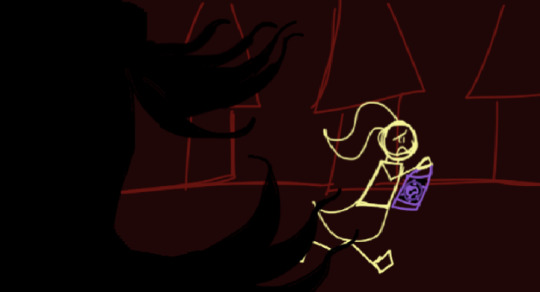
*That leader, by the way, was Cassidy on an important mission from Old Man Consequences himself. What was that mission? Unfortunately, Glitch never found out since he soon shoved her into a lake buried within the code. He did pick up her role as Judge and absorbed it into his “DNA”, though, so he got that far.
*That did not stop him from noticing what the lantern contained, getting repulsed by it, and almost simultaneously depleting its remnant and tossing it into the lake. He was going to remove this corrupted thing one way or another.
*Suddenly, from the courtyard, the King of Princess Quest himself stops this madness. They argue for a bit, talking about responsibilities and “roles” and such. Then the argument takes a strange turn when the king sprite reveals its true form: Old Man Consequences. And, being true to his name, he warns the rabbit of the consequences of what’ll happen if he goes through with this: Glitch will be no better than the man who made his code ages ago. In fact, he might even be worse (as if he wasn’t already..).
*So, fearing that possibility, Glitch strikes a deal with the Old Man: Glitch takes care of this misshapen creature, but both of them have to live in the Kingdom part of the Pizzaplex. The Old Man, though obviously knowing that this’ll result in both Glitch and William getting more press and/or control at the ‘Plex, agrees.

*It takes a few years (and many incidents a la the Tales books for the preparations to begin), but the pair do finally show up at the mall. Now completely ready to start his actual work, Glitch commits to his role as Judge of the Kingdom and starts fully manipulating the completely-transferred William (now referred to as “Agonia”) behind the scenes.
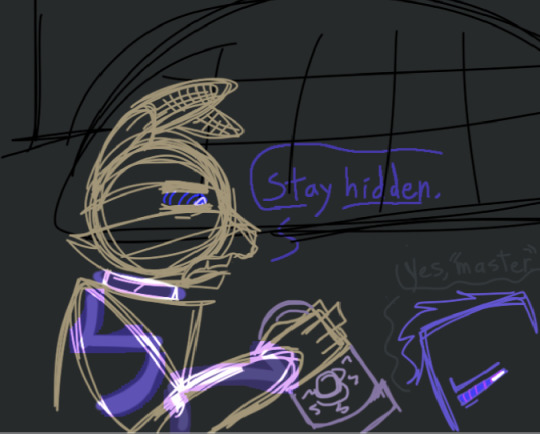
*So, yes, by the time we hit SB and Ruin in this timeline, many years have already passed. William is used to his job as bell-ringer and code maintenance for the area, Glitch calls the shots for the shows in the Fazbear Kingdom area, and Vanny and Greg are doing their cat-and-mouse thing anywhere other than this place. All in all, a somewhat chill place to be at night... For now.
*Oh, and uh... Sun only knows about the whole Cassidy incident thanks to the Princess Quest devs seeing the aftermath in their code log the next morning. Obviously not questioning anything and only sensing an opportunity to reference the Bells of Notre Dame song, they begged the higher-ups at Fazbear’s for permission to turn their weird fluke into a story just like that. By some miracle, those high-ups agreed and put that story into Sun’s system.
*So, yeah, if it weren’t for some silly shenanigans both at the Design Department and the Board Room of some Fazbear higher-ups, this AU wouldn’t have happened and the story of SB would’ve been normal. Thank those guys, I guess?
*Hang on, editing with one more crucial detail: Glitch not only took on Cassidy’s role, but he also literally stole most of William’s voice to make the manipulation process easier. That’s why Agonia is (predominantly) voiceless and Glitchtrap sounds more cold yet human in general. If Agonia did talk, it’d sound as hoarse and frail as you’d expect.
#william afton#glitchtrap#hunchback of notre dame#notre dame au#pond rambles#pond’s art#pond’s sketch#worldbuilding#(maybe too much idk)#(might simply this down the road)#fnaf security breach#fnaf ruin#fnaf au
6 notes
·
View notes
Photo
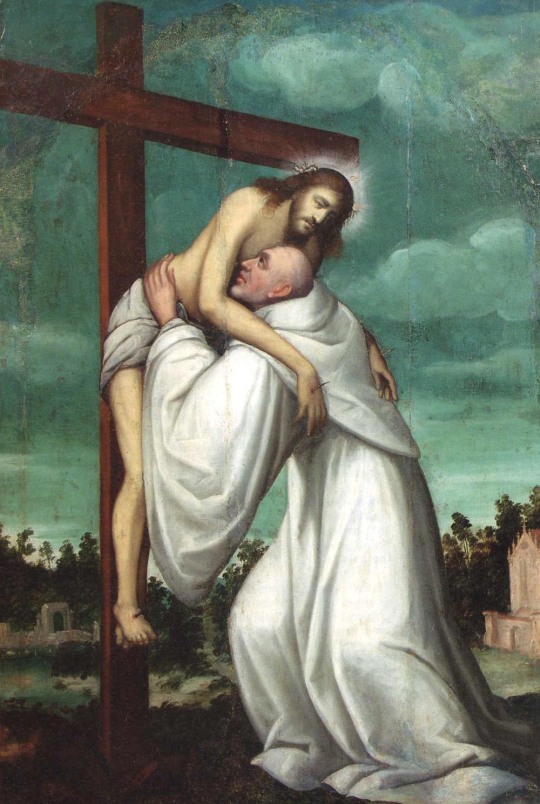
THE DESCRIPTION OF SAINT BERNARD OF CLAIRVAUX
Feast Day: August 20
"God will either give us what we ask, or what He knows to be better for us."
The abbot of Clairvaux, confessor, the Last of the Fathers, the Doctor Mellifluus, and a Doctor of the Church, was born of a noble family at Fontaine-lès-Dijon, Burgundy, Kingdom of France in 1090. Bernard was the third of seven children, and his parents were Tescelin de Fontaine, lord of Fontaine-lès-Dijon, and Alèthe de Montbard, both members of the highest nobility of Burgundy. At the age of 9, he was sent to a school at Châtillon-sur-Seine run by the secular canons of Saint-Vorles, and had an interest in literature and rhetoric. He had a special devotion to the Virgin Mary, and he later wrote several works about the Queen of Heaven. At 19, he lost his mother, and during his youth, he did not escape trying temptations and around this time he thought of living a life of solitude and prayer. At the age of 22, while he was at prayer in a church, he felt the calling of God to enter the Cistercian Monks of Cîteaux.
His testimony was so irresistible that 30 of his friends, brothers and relative followed him into monastic life. Three years later, Bernard was sent with 12 monks to found a new monastery at Clairvaux, a forested place in the Valley of Wormwood. The reputation of his holiness soon attracted 130 new monks, including his own father. During the absence of the Bishop of Langres, Bernard was blessed as abbot by William of Champeaux, Bishop of Châlons-sur-Marne. From then on a strong friendship grew between the abbot and the bishop, who was professor of theology at Notre Dame of Paris and the founder of St. Victor Abbey in Paris.
One day in order to cool down his lustful temptation, he threw himself into ice-cold water. Another time, while sleeping in an inn, a prostitute was introduced naked beside him, and he saved his chastity by running. Many miracles were attributed to his intercession. One time, he restored the power of speech to an old man that he might confess his sins before he died. Another time, an immense number of flies, that infested the Church of Foigny, died instantly after the excommunication he made on them. So great was his reputation that Princes and Popes sought his advice, and even the enemies of the Church admired his holiness of his life and the greatness of his writings. Bernard then passed into Germany, and the reported miracles which multiplied almost at his every step undoubtedly contributed to the success of his mission. Conrad III of Germany and his nephew, the future Holy Roman Emperor, Frederick Barbarossa, received the cross from the hand of Bernard.
In 1128, Bernard participated in the Council of Troyes, which had been convoked by Pope Honorius II, and was presided over by Cardinal Matthew of Albano. The purpose of this council was to settle certain disputes of the bishops of Paris, and regulate other matters of the Church of France. The bishops made Bernard secretary of the council, and charged him with drawing up the synodal statutes. After the council, the bishop of Verdun was deposed. It was at this council that Bernard composed a rule for the Knights Templar; it soon became an ideal of Christian nobility. Around this time, he praised them in his 'Liber ad milites templi de laude novae militiae (Book to the Knights of the Temple, in praise of the new knighthood)'.
In 1144, Bernard was commissioned by Pope Eugene III to preach the Second Crusade. Moved by his burning words, many Christians embarked for the Holy Land, but the Crusade ended in total miserable failure. That proved that even saints sometimes can commit mistakes. He died on August 20, 1153 at the age of 62 or 63, in Clairvaux Abbey in the province of Champagne (modern day part of Ville-sous-la-Ferté).
Canonized a saint by Pope Alexander III on January 18, 1174 and declared a Doctor of the Church by Pope Pius VIII in 1830, his major shrine can be found at the famed Troyes Cathedral (Cathédrale Saint-Pierre-et-Saint-Paul), where his 12th century reliquary is held. Bernard is the patron saint of candlemakers, beekeepers, and the Poor Fellow-Soldiers of Christ and of the Temple of Solomon aka the Knights Templar.
11 notes
·
View notes
Text
youtube
The feast of the fools, also called the feast of the ass, was destined to honor the donkey that carried Jesus during his entry into Jerusalem. In these holidays, celebrated after Christmas, the altar boys and priests reversed their roles while conducting the rites. The practice was particularly widespread in Notre Dame in Paris and in many European churches; in Italy similar cases are witnessed as in a famous missal of 1200 from the cathedral of Padua. The basic scheme of this particular event was always the same: during vespers, when the verse in which God overthrows the powerful from their thrones and raises the humble was read, a great din exploded from the choir, obviously prepared. The minor orders and the altar boys then chased the priests from their chairs and took their place, while a young cleric flanked the bishop during the rest of the rite assuming the role of pope of fools, bishop of fools or abbot of fools. At the end of the service he received the same honors as the real prelate, and his chaplain was to pronounce a blessing that comprehend: liver disease, a banquet of forgiveness, twenty banquets of toothache and two ringworms under the chin.Young people caught in bed on the day of the Innocents (December 28) received slaps on the back. In various cities the canons, clergymen and sometimes seculars were caught in their bed in the morning and, in a state of complete nakedness, led through the streets, into churches and onto the altar where they were mocked. Even the clergymen actively participated with jokes during the day of the Innocents walking naked through the city or exhibiting men, naked, in the theaters. Biblical scenes were represented in these periods of the year and with the passage of time these theatrical performances reached a point where some saints were even attributed a fixed characteristic; St. Peter was the most funny, St. Thomas was the incredulous and so on. The years passed and the holidays became more and more extreme and profane. Although their initial peaceful acceptance was testified by their inclusion in liturgical missals, in the following centuries these feasts and theatrical performances were limited and in 31 December 1519 the feast was gradually banned by the religious and civil authorities.
#music#medieval#medieval music#insane discordant harmonies that culminate around 27min in a rythm meant to sound like the braying of an ass#also there was a bit more in the description#but the guy writing it started to sound like he was becoming the Joker#Youtube#holiday
2 notes
·
View notes